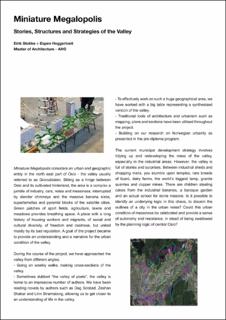Miniature Megalopolis - Stories, Structures and Strategies for the Valley
Master thesis
Submitted version

Åpne
Permanent lenke
https://hdl.handle.net/11250/2651800Utgivelsesdato
2019-12Metadata
Vis full innførselSamlinger
Beskrivelse
Miniature Megalopolis considers an urban and geographic entity in the north east part of Oslo - the valley usually referred to as Groruddalen. Sitting as a hinge between Oslo and its hinterland, the area is a complex jumble of industry, cars, noise and messiness, interrupted by slender chimneys and the massive banana slabs, superlamellas and pyramid blocks of the satellite cities. Green patches of sport fields, agriculture, lawns and meadows provide breathing space. A place with a long history of housing workers and migrants, of social and cultural diversity, of freedom and coolness, but united mostly by its bad reputation.
A goal of the project became to provide an understanding and a narrative for the urban condition of the Valley. Is it possible to identify an underlying logic in this chaos, to discern the outlines of a city in the urban noise? Could this condition of messiness be celebrated and provide a sense of autonomy and resistance, in stead of being swallowed by the planning logic of central Oslo?
As an approach to this intergrown condition, the urbanity of the valley is understood as a product of a Norwegian planning tradition. In the post-war era, the valley became the most important testing ground for radical urban experiments, and key to understanding any decade of Norwegian urbanism. This urban approach is understood through five principles which are used as entry points for analysing the valley: nature, views, center, church and fields. Critically reflecting on the development of the satellite cities, a new urban project is proposed. Five parallel strategies are developed, playing out all levels of urbanism, from top-down to bottom-up. The speculated implementations reveal new models of production and life, emancipating the Valley from central Oslo.
